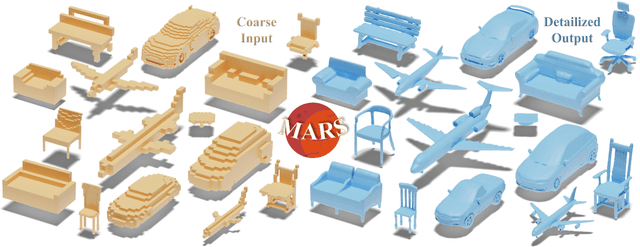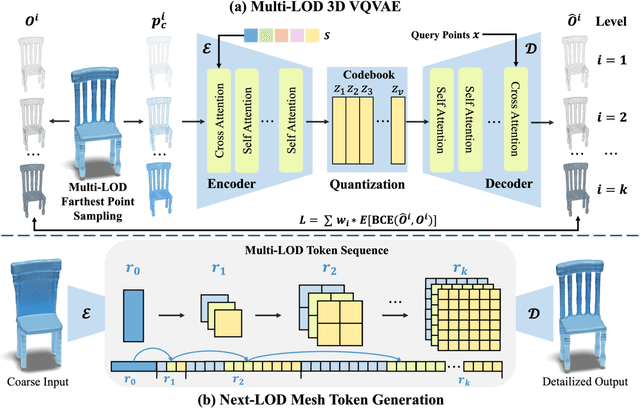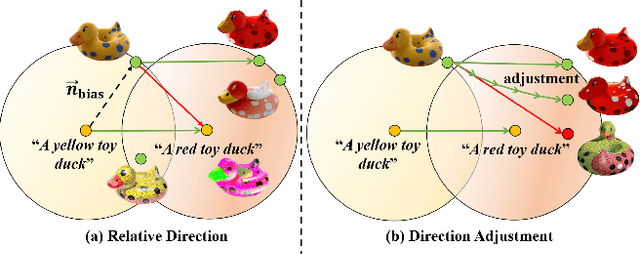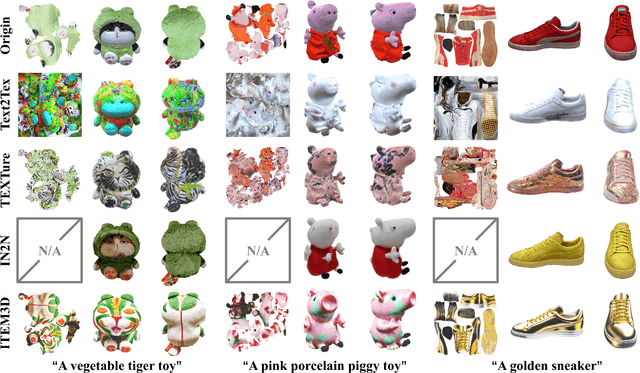Jingnan Gao
MARS: Mesh AutoRegressive Model for 3D Shape Detailization
Feb 17, 2025



Abstract:State-of-the-art methods for mesh detailization predominantly utilize Generative Adversarial Networks (GANs) to generate detailed meshes from coarse ones. These methods typically learn a specific style code for each category or similar categories without enforcing geometry supervision across different Levels of Detail (LODs). Consequently, such methods often fail to generalize across a broader range of categories and cannot ensure shape consistency throughout the detailization process. In this paper, we introduce MARS, a novel approach for 3D shape detailization. Our method capitalizes on a novel multi-LOD, multi-category mesh representation to learn shape-consistent mesh representations in latent space across different LODs. We further propose a mesh autoregressive model capable of generating such latent representations through next-LOD token prediction. This approach significantly enhances the realism of the generated shapes. Extensive experiments conducted on the challenging 3D Shape Detailization benchmark demonstrate that our proposed MARS model achieves state-of-the-art performance, surpassing existing methods in both qualitative and quantitative assessments. Notably, the model's capability to generate fine-grained details while preserving the overall shape integrity is particularly commendable.
AniSDF: Fused-Granularity Neural Surfaces with Anisotropic Encoding for High-Fidelity 3D Reconstruction
Oct 02, 2024Abstract:Neural radiance fields have recently revolutionized novel-view synthesis and achieved high-fidelity renderings. However, these methods sacrifice the geometry for the rendering quality, limiting their further applications including relighting and deformation. How to synthesize photo-realistic rendering while reconstructing accurate geometry remains an unsolved problem. In this work, we present AniSDF, a novel approach that learns fused-granularity neural surfaces with physics-based encoding for high-fidelity 3D reconstruction. Different from previous neural surfaces, our fused-granularity geometry structure balances the overall structures and fine geometric details, producing accurate geometry reconstruction. To disambiguate geometry from reflective appearance, we introduce blended radiance fields to model diffuse and specularity following the anisotropic spherical Gaussian encoding, a physics-based rendering pipeline. With these designs, AniSDF can reconstruct objects with complex structures and produce high-quality renderings. Furthermore, our method is a unified model that does not require complex hyperparameter tuning for specific objects. Extensive experiments demonstrate that our method boosts the quality of SDF-based methods by a great scale in both geometry reconstruction and novel-view synthesis.
Multi-times Monte Carlo Rendering for Inter-reflection Reconstruction
Jul 08, 2024Abstract:Inverse rendering methods have achieved remarkable performance in reconstructing high-fidelity 3D objects with disentangled geometries, materials, and environmental light. However, they still face huge challenges in reflective surface reconstruction. Although recent methods model the light trace to learn specularity, the ignorance of indirect illumination makes it hard to handle inter-reflections among multiple smooth objects. In this work, we propose Ref-MC2 that introduces the multi-time Monte Carlo sampling which comprehensively computes the environmental illumination and meanwhile considers the reflective light from object surfaces. To address the computation challenge as the times of Monte Carlo sampling grow, we propose a specularity-adaptive sampling strategy, significantly reducing the computational complexity. Besides the computational resource, higher geometry accuracy is also required because geometric errors accumulate multiple times. Therefore, we further introduce a reflection-aware surface model to initialize the geometry and refine it during inverse rendering. We construct a challenging dataset containing scenes with multiple objects and inter-reflections. Experiments show that our method outperforms other inverse rendering methods on various object groups. We also show downstream applications, e.g., relighting and material editing, to illustrate the disentanglement ability of our method.
A Comparative Study of Perceptual Quality Metrics for Audio-driven Talking Head Videos
Mar 11, 2024Abstract:The rapid advancement of Artificial Intelligence Generated Content (AIGC) technology has propelled audio-driven talking head generation, gaining considerable research attention for practical applications. However, performance evaluation research lags behind the development of talking head generation techniques. Existing literature relies on heuristic quantitative metrics without human validation, hindering accurate progress assessment. To address this gap, we collect talking head videos generated from four generative methods and conduct controlled psychophysical experiments on visual quality, lip-audio synchronization, and head movement naturalness. Our experiments validate consistency between model predictions and human annotations, identifying metrics that align better with human opinions than widely-used measures. We believe our work will facilitate performance evaluation and model development, providing insights into AIGC in a broader context. Code and data will be made available at https://github.com/zwx8981/ADTH-QA.
EvaSurf: Efficient View-Aware Implicit Textured Surface Reconstruction on Mobile Devices
Nov 18, 2023Abstract:Reconstructing real-world 3D objects has numerous applications in computer vision, such as virtual reality, video games, and animations. Ideally, 3D reconstruction methods should generate high-fidelity results with 3D consistency in real-time. Traditional methods match pixels between images using photo-consistency constraints or learned features, while differentiable rendering methods like Neural Radiance Fields (NeRF) use differentiable volume rendering or surface-based representation to generate high-fidelity scenes. However, these methods require excessive runtime for rendering, making them impractical for daily applications. To address these challenges, we present $\textbf{EvaSurf}$, an $\textbf{E}$fficient $\textbf{V}$iew-$\textbf{A}$ware implicit textured $\textbf{Surf}$ace reconstruction method on mobile devices. In our method, we first employ an efficient surface-based model with a multi-view supervision module to ensure accurate mesh reconstruction. To enable high-fidelity rendering, we learn an implicit texture embedded with a set of Gaussian lobes to capture view-dependent information. Furthermore, with the explicit geometry and the implicit texture, we can employ a lightweight neural shader to reduce the expense of computation and further support real-time rendering on common mobile devices. Extensive experiments demonstrate that our method can reconstruct high-quality appearance and accurate mesh on both synthetic and real-world datasets. Moreover, our method can be trained in just 1-2 hours using a single GPU and run on mobile devices at over 40 FPS (Frames Per Second), with a final package required for rendering taking up only 40-50 MB.
ITEM3D: Illumination-Aware Directional Texture Editing for 3D Models
Sep 27, 2023



Abstract:Texture editing is a crucial task in 3D modeling that allows users to automatically manipulate the surface materials of 3D models. However, the inherent complexity of 3D models and the ambiguous text description lead to the challenge in this task. To address this challenge, we propose ITEM3D, an illumination-aware model for automatic 3D object editing according to the text prompts. Leveraging the diffusion models and the differentiable rendering, ITEM3D takes the rendered images as the bridge of text and 3D representation, and further optimizes the disentangled texture and environment map. Previous methods adopt the absolute editing direction namely score distillation sampling (SDS) as the optimization objective, which unfortunately results in the noisy appearance and text inconsistency. To solve the problem caused by the ambiguous text, we introduce a relative editing direction, an optimization objective defined by the noise difference between the source and target texts, to release the semantic ambiguity between the texts and images. Additionally, we gradually adjust the direction during optimization to further address the unexpected deviation in the texture domain. Qualitative and quantitative experiments show that our ITEM3D outperforms the state-of-the-art methods on various 3D objects. We also perform text-guided relighting to show explicit control over lighting.
 Add to Chrome
Add to Chrome Add to Firefox
Add to Firefox Add to Edge
Add to Edge